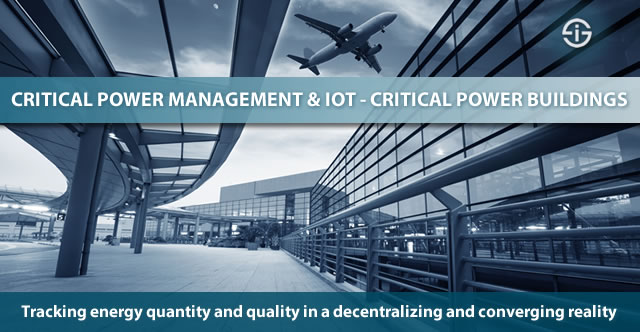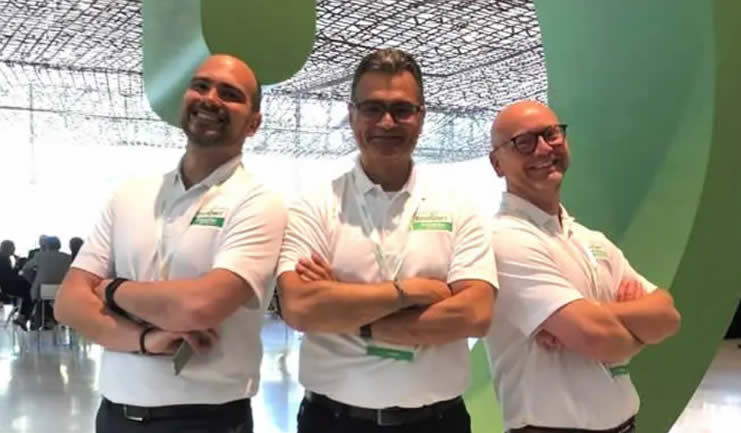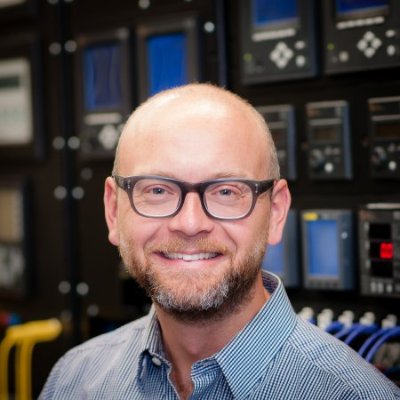Interview with Kevin Morin, who is responsible for the Critical Power badge of Schneider Electric’s EcoXpert partner program, on the importance of IoT and evolutions in critical power buildings and power management.
Previously we looked at the opportunities that IoT and the convergence of IT and OT in low voltage environment solutions offer to small and medium buildings and the electrical contractors who serve them.
In critical power the major implications of IoT involve the proliferation of sensors, and in particular energy metering.
While for many facility managers of power-critical facilities energy consumption, energy monitoring, energy savings and energy conservation are essential, there is a specific sub-segment of buildings, where outage avoidance, electrical equipment reliability, and electrical system management is far more critical. There are several buildings where power and thus power management is critical. Also in Industry 4.0 critical power and energy efficiency is taking center stage.

Kevin Morin is responsible for the Critical Power certification (power management systems and advanced metering) badge of Schneider Electric’s awarded EcoXpert partner program and tells us all about IoT in critical power buildings. He gives some examples of such buildings: airports, hospitals, data centers, process industry and other buildings where electricity is critical in a sense that when it’s lost or disrupted through poor quality it poses a significant safety and/or cost issue.
The difference between power management and building management systems
For people responsible for these types of buildings, Kevin Morin says, it’s not just important to manage the amount of energy from a cost and compliance perspective but is equally essential that the quality and reliability of their energy systems is high, among others through power quality monitoring.
With power management systems, we come closer to providing functionality that some might expect to see in building energy management systems (BEMS), in building management and in Building Management Systems, although there is a first difference here.
Building management systems have the control of temperature/HVAC, primarily for comfort of occupants (and, indeed, building management and IoT are increasingly connected as well).
Power management systems, however, not only track energy performance of the BMS, they should also provide important insights into power distribution parameters throughout the building in both real-time and as a trend over time, Kevin explains.
The ability to provide a deeper dive into the challenges, evolutions, solutions and role of IoT technologies in critical power buildings is an expected capability of integrators who are Certified with the EcoXpert Critical Power certification.
The critical power management ecosystem: a broad range of integrators and partners
Kevin, at the occasion of a look at the role of IoT in low voltage connected power environments which we typically find in small and medium buildings, electrical contractors were mentioned as the key partners who serve end customers. Do you encounter the same types of partners? Or are they the same types of companies we see in BMS? Or is it another ecosystem, given the different focus of power management systems?
Kevin Morin: It is a diverse landscape and there are some overlaps with other partner ecosystems.
As you mention, in small or medium sized buildings, specialized solutions are required to help improve energy cost management and electrical equipment maintenance. In this scenario, an electrical contractor and simple connected technology from Schneider Electric might be enough.
Typically, our EcoXpert Critical Power badge holders are very technically skilled, and many are involved in software development and integration. So, they have programming language knowledge, and experience in programming hardware such as a PLC or other field controllers.
There are some panel builders, who assemble all the circuit breakers and components in a low voltage distribution environment who want to go further in providing a full power management system, with more advanced monitoring control functionality. There are others who are automation system integrators, for instance doing industrial automation or building automation.
Pervasive metering offers a huge opportunity to track energy usage. Pervasive metering energy tracking optimizes both energy quantity and energy quality (Kevin Morin)
Commercially, there is diversity too, we have partners who focus solely on electric utilities and others that focus on providing services in critical power from a consulting perspective and offer solutions to fix power quality issues as well.
As you see, indeed a diverse landscape. If you need a BMS expert you can take a phone book or use the Internet to find a business partner, in critical power management it’s different.
What makes all of the critical power partners unique, however, is that they have some experience with power systems, cabling and electrical infrastructure, want to move towards managing that electrical infrastructure and work with large and premium buildings where electricity is critical.
Critical power management and IoT: tracking energy quantity and quality in a decentralizing reality
Which are the types of IoT use cases that you see most with your current partners in this critical power environment and how do you see that to evolve over time?
Kevin Morin: For Critical Power EcoXperts, the major implications of IoT involve the proliferation of sensors, and in particular energy metering (smart metering). From the hardware perspective this is also the main part of the power management system.
You get a meter from the utility company, which is owned by the utility and is used to charge you for your energy bill, based on the consumption from that meter. Our partners put meters all throughout the building so the customer can see the cost of energy at different areas of the building and can also track the energy quality at these different areas.
This pervasive metering means that there is a huge opportunity to track energy usage which encompasses both energy quantity and energy quality.
Over time, as energy becomes an increasingly digital given with sensors, while also becoming more decentralized with energy coming from a local solar photovoltaic, wind or microgrid system in the smart grid, users will have even more control and ability to manage their energy usage. This is also what we want our Critical Power EcoXpert partners to be thinking about.
Measure, understand and act: managing electricity cost, flow and assets
What are the other components of power management systems in critical power environments?
Kevin Morin: It is an integrated system with power meters, power management software and power quality mitigation equipment, which helps improve the quality of the power.
These various parts enable what we call a “Measure, Understand and Act” approach:
- Measure with smart meters,
- Understand with our software and all the reporting and dashboards, and
- Act, which is developing solutions to improve the quality and therefore the reliability of energy.
EcoXpert partners focus on several types of applications to configure solutions for their customers. These applications revolve around three main value propositions:
- managing energy cost,
- managing the electrical network, which is the flow of electricity throughout the building and
- managing the electrical assets, such as circuit breakers and transformers.

A focus on IoT enabled critical power solutions: energy accounting and power availability
Can you give some examples of such application and the role of solutions and services for your partners in an IoT reality?
Kevin Morin: Energy accounting is an application that very often gets the attention of our partners first. It involves anything related to managing energy cost and saving on energy cost.
By way of an example: a large university might receive one bill from their electric utility but want to divide that bill because they have departments or different tenants within the campus who want individual bills. That’s where energy accounting comes in.
A second example is power availability. Here we have applications that look at factors which are related to the quality of power or the reliability of power in the facility.
Let’s take the example of a hospital which has a generator that would run if there is a utility disconnect? With a power availability solution we help them track 1) how efficiently the generator is running and 2) how reliable that running is.
The switching to the generator needs to happen immediately when there is power disruption. A power availability solution also shows how smoothly is that transition happening, and ultimately record the transition for reporting to regulatory authorities.
Power management systems not only track energy performance of the BMS, they should also provide important insights into power distribution parameters throughout the building in both real-time and as a trend over time (Kevin Morin)
For Critical Power EcoXperts it’s important to have differentiated solutions that enable them to offer something unique to their customers.
We help them achieve that by offering access to information on our product roadmap and how various products and even additional certifications can help them. They want system architectures that are highly focused on intelligent services, integration tools and specialized training as we are in this vast IoT-enabled landscape of the convergence of critical systems facilities with mechanical, electrical, security and complex installation integration challenges in buildings that can be optimized and managed in a faster, deeper and better way than ever.
The impact of IoT: decision interfaces and system integration as silos of infrastructure disappear
EcoXpert business partners are active in several areas of expertise, ranging from power management to building management systems. How does this impact the EcoXpert partner program on one hand and the opportunities to leverage IoT in all these segments on the other?
Kevin Morin: The integration of systems is a key topic. IoT will drive a huge amount of new data. However, as users of that data, customers will become overwhelmed and they demand simple interfaces and software tools that not only provide a single interface, but also an interface that helps them to understand that data and turn it into information so they can make better decisions.
We see this integration happening today in many areas. Take a building that now has solar power on the roof, for example. That’s partially a matter of electrical systems but also of mechanical systems as the created energy could be used to power chillers that cool the building or reduce the another energy cost. So, all these different systems will have to communicate with each other and that requires expertise.
With IoT and connected applications, silos of infrastructure become a thing from the past.
This also goes for the different stakeholders in the context of such a building. Today an IT manager will be rarely involved in the security of the networks which are used and built for critical power management as they run separately from the IT network. However, they should and will be more involved as IT and OT integrate and security is always key.
In the future world of ever more Internet of Things and connected applications, silos of infrastructure will become a thing from the past. EcoXperts which are trained in multiple disciplines, are better positioned to provide system integration in that future world, just as they are already in today’s world.
Disclaimer: we deliver services to Schneider Electric’s EcoXpert program, including content services. Top image: Shutterstock – Copyright: hxdyl


